Golden Monkeys are subspecies of blue monkeys. They are similar to blue monkeys in almost every way except for the golden/orange patch found on their back and upper flanks. The golden colors around these monkeys make them one of the best looking of primates. Golden monkeys of Africa are sometimes confused with the Golden Snub-nosed Monkey of China. The golden monkeys covered in this article are found in Central and East Africa. More specifically, they can be found in Virunga and Kahuzi-Biega National Park of Congo, Volcanoes National Park of Rwanda and Mgahinga National Park of Uganda. Small populations are also believed to be living in Nyungwe National Park and Gishwati Makura National Park of Rwanda.
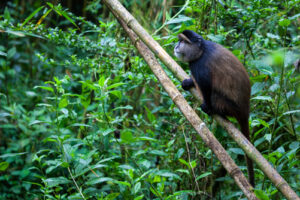 Golden monkeys are very social primates. They live in groups of about 30 individuals on average and prefer mountain slopes with bamboo or highland forest. Much of their diet consists of fruits and bamboo. They do not stay in one place for long but move about the forest looking for areas with ripe fruits. The dry season means a lot of sweet ripe fruits while the beginning of the rainy season supports the growth of nutritious bamboo shoots. Golden monkeys prefer areas with a mix of bamboo and fruits but will also raid human gardens for things like potatoes.
Golden monkeys are very social primates. They live in groups of about 30 individuals on average and prefer mountain slopes with bamboo or highland forest. Much of their diet consists of fruits and bamboo. They do not stay in one place for long but move about the forest looking for areas with ripe fruits. The dry season means a lot of sweet ripe fruits while the beginning of the rainy season supports the growth of nutritious bamboo shoots. Golden monkeys prefer areas with a mix of bamboo and fruits but will also raid human gardens for things like potatoes.
According to the International Union for Conservation of Nature (IUCN), golden monkeys are considered to be endangered and hence included in their list. Only about 4000 golden monkeys still roam the planet. The greatest threat to golden monkeys are humans and their activities. Encroachment on forests and other illegal human activities such as mining, deforestation has led to shrinking golden monkey habitats. As their natural homes become human settlements, food becomes scarce hence forcing the primates to raid gardens. In such cases, they are viewed as pests and hunted down by angry local farmers. The Governments in Uganda, Rwanda and Congo are aware of the threats to golden monkeys and have put in effort to stop their declining numbers. Effort has been put in sensitizing communities living close to golden monkey habitat about the importance of the primates to the ecosystem. The governments are also including golden monkey trekking as a tourism product to help raise funds for their conservation.
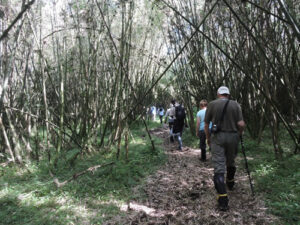 How can you help protect the golden monkey? You can do this by consulting the Dian Fossey Foundation and learning about their Golden monkey conservation action plan in partnership with the International Union for the Conservation of Nature. The Dian Fossey Foundation may be having sponsorship programs geared towards involving individuals in conservation. Another way to support golden monkey conservation is to visit them in the wilds of Africa. Tourism played a big part in saving mountain gorillas from extinction by helping raise the funds required for building infrastructure, sensitizing local communities and recruiting armed Rangers to deal with poachers. When communities benefit from tourism, they are less likely to harm wildlife. You can learn more about golden monkey trekking in Rwanda and Uganda or check out our 2 Days Golden monkey trekking package in Rwanda. There is even the 3 Days Rwanda gorilla and golden monkey package for more fun. If you have more time to spend, why not go for the 7 Days Rwanda primates tour where you can also see chimpanzees. We can now go into the more details facts about golden monkeys below: –
How can you help protect the golden monkey? You can do this by consulting the Dian Fossey Foundation and learning about their Golden monkey conservation action plan in partnership with the International Union for the Conservation of Nature. The Dian Fossey Foundation may be having sponsorship programs geared towards involving individuals in conservation. Another way to support golden monkey conservation is to visit them in the wilds of Africa. Tourism played a big part in saving mountain gorillas from extinction by helping raise the funds required for building infrastructure, sensitizing local communities and recruiting armed Rangers to deal with poachers. When communities benefit from tourism, they are less likely to harm wildlife. You can learn more about golden monkey trekking in Rwanda and Uganda or check out our 2 Days Golden monkey trekking package in Rwanda. There is even the 3 Days Rwanda gorilla and golden monkey package for more fun. If you have more time to spend, why not go for the 7 Days Rwanda primates tour where you can also see chimpanzees. We can now go into the more details facts about golden monkeys below: –
Facts About Golden Monkeys
Only found in Africa: Golden monkeys are endemic to Africa. They can only be found in areas around the Virunga mountains and Kahuzi Biega National Park. These parks offer a conducive environment for them to live in because there is abundant supply of fruits and bamboo leaves.
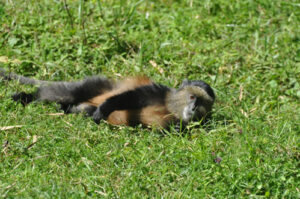 Name derived from their skin color: Golden monkeys derive their name from the golden patterns that make up parts of their bodies. Golden/orange colors can be seen in areas around their cheeks, backs and long tails. The golden patches are lighter on the female golden monkeys as compared to the male ones.
Name derived from their skin color: Golden monkeys derive their name from the golden patterns that make up parts of their bodies. Golden/orange colors can be seen in areas around their cheeks, backs and long tails. The golden patches are lighter on the female golden monkeys as compared to the male ones.
Communicate using distinct sounds and facial expressions: These sounds can be made by male golden monkeys to communicate distress, when dealing with a threat or when intruders invade their territories. Young golden monkeys also make specific sounds to show submission towards the older members of the troop. The females will make sounds that are meant to show unity and content within the group.
Eagles are their main prey but they have a Long Lifespan given their small size: Golden monkey can live between 19 to 20 years in the wild. In captivity, golden monkeys usually live longer. Golden monkeys are small primates. The males weigh between 4.5 to 7 kilograms while the females weigh between 3.5 to 4.5 kilograms. Because of their small size, eagles prey on them whenever they can. Golden Monkeys are particularly vulnerable when it rains because they have difficulty seeing the direction of danger. The monkeys are also afraid of lightening.
Polygamous males: Golden monkey males mate with all the females in their troop. The females are the ones that initiate the mating process. After the mating process, it takes 5 months for a young one to 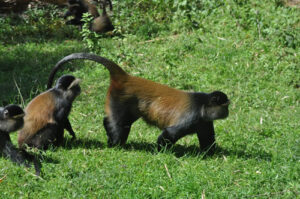 be born. The young monkeys are groomed and nursed by their mothers for about two years when they reach maturity. Male golden monkeys leave the group to join other troops and start a new life. Young female golden monkeys often stay with their original families all their lives
be born. The young monkeys are groomed and nursed by their mothers for about two years when they reach maturity. Male golden monkeys leave the group to join other troops and start a new life. Young female golden monkeys often stay with their original families all their lives
Very social and playful primates: Golden monkeys are very social, playful, cute and cheeky primates. They are fun to watch in their natural habitats and that is why tourists love them. They live in groups which are made up of a few males with many females and their young ones. A dominant male heads each golden monkey group. The role of the dominant male is to protect his troop from danger and other rogue males. Females can also be seen guarding their territories especially when the dominant male is temporarily away from the group. Golden monkeys sleep in groups during their resting time for safety. They construct nest from bamboo and return to use it at the end of the day.
Herbivores Primates but also feed on insects: Golden monkeys feed on plant leaves, flowers, shoots and roots from selected species of plants. One of their favorite plants is the bamboo tree. Golden monkeys enjoy bamboo leaves and shoots more than any other foliage. They developed a taste for bamboo as a result of living in mountainous areas. Mountain slopes support the growth of bamboo 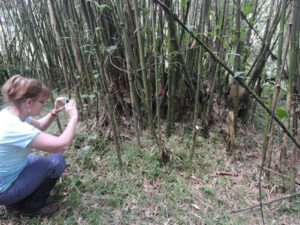 vegetation. Golden monkeys also enjoy wild fruits which grow seasonally in the forests. Fruits offer them the opportunity to diversify their usual diets of foliage. Apart from fruits and bamboo, golden monkeys also occasionally feed on worms/insects.
vegetation. Golden monkeys also enjoy wild fruits which grow seasonally in the forests. Fruits offer them the opportunity to diversify their usual diets of foliage. Apart from fruits and bamboo, golden monkeys also occasionally feed on worms/insects.
Highly endangered: As already highlighted earlier, Golden monkeys are under threat from extinction. Activities like forest encroachment and deforestation has led to the destruction of natural golden monkey habitats. Golden monkeys have also fallen victim to poaching activities aimed at getting their body parts to be sold in the black market and for medicinal purposes. It’s therefore important that communities join hands to conserve and protect the golden monkeys before they are wiped out of the earth.

